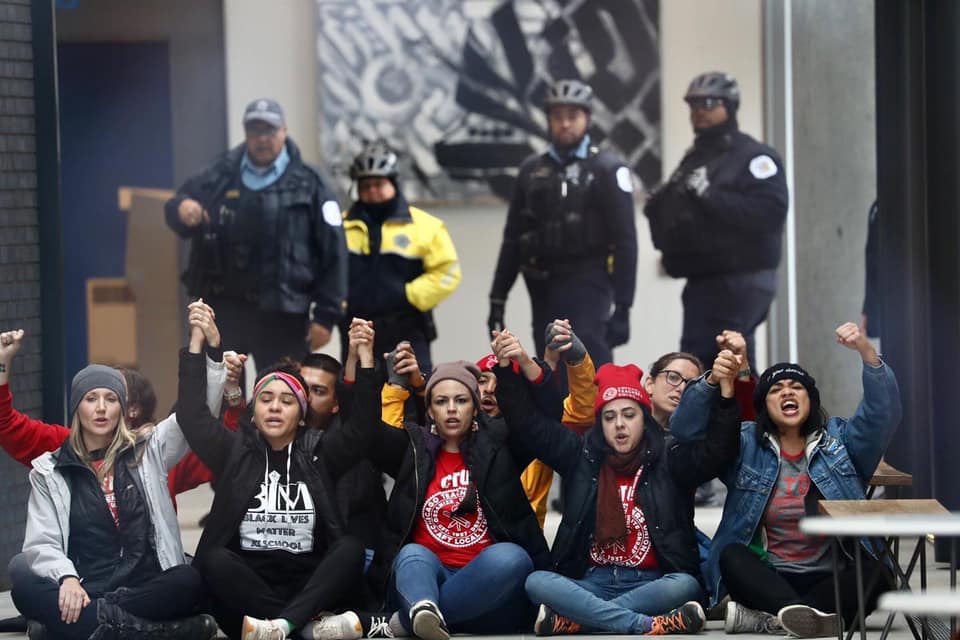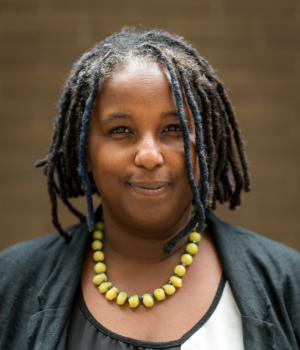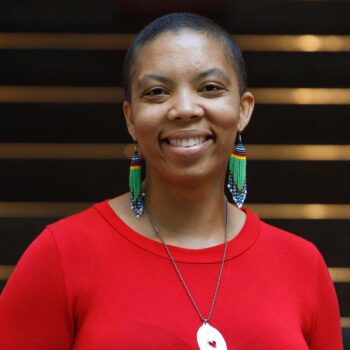“Our Contract Should Represent the Common Good”
In the fall of 2019, a sea of red shirts processed through the streets of Chicago. The powerful photos of strikers and marchers and the banners they carried, “A Nurse in Every School”, “Fighting for the schools Chicago Children Deserve,” made clear this was a different kind of labor action. Teachers, school janitors, teacher aides, other paraprofessional workers, and parents were committing to sacrifice on behalf of the children of this mostly Black and Brown city. It was a demand that the city find redemption for its past neglect of the children of its school system. The strike was a call to the community and city government to step forward and love these kids, to collectively take responsibility for them with their parents. Every day the strike communicated to Chicago Public Schools’ students: “You are worth it, you are worth everything.” The value of nurturing, social reproduction and care were centered in this struggle… this is what intersectional feminism looks like.
“This struggle is about justice and equity….” Stacy Davis-Gates, Executive Vice President of the Chicago Teachers Union (CTU), explained. “Teachers are tasked with creating the common good by offering a great education and so our contract should also represent the common good to give us the tools to make sure that happens.” This strategy of “Bargaining for the Common Good” (BCG) means that collective bargaining provides a means/method to ensure key structural improvements that are enforceable for members and the public/communities these unions serve. There are several key elements of BCG including:
-
Bargaining beyond wages and benefits;
-
Identifying, exposing and challenging the real villains;
-
Community allies as decision-making partners in issue development and bargaining;
-
Demands centered on racial justice;
-
Strong internal organizing and member engagement;
-
Leveraging capital controlled by members in campaigns; and
-
Ongoing campaigns – they start before and extend beyond the bargaining period.
The overall goal is to build powerful movements that “fight and win” for the common good.
“CTU and the Grassroots Collaborative and others have argued that the district is not actually broke — that it’s “broke on purpose,” in order to justify austerity measures.” Jacobin
CTU, with other community and union allies and in deep partnership with Grassroots Collaborative, led by Executive Director Amisha Patel, proved that big change is possible with a broad and diverse movement and the will to expand bargaining beyond “bread and butter” issues. Rather than narrowing to a single-issue focus that operated within the city leadership’s dominant narrative that “Chicago is broke” and their calls for austerity, this BCG movement “talked back” (hooks, 1989) by demonstrating through a “fierce critical interrogation” (hooks, 1990) that the city was “broke on purpose.” By tying citywide concerns about how public dollars were being used to reward private developers and contractors together with concerns about the state of the cities’ public schools and concerns of workers deteriorating working conditions in schools, this CTU Strike was able to win more with greater impact for a broader community. This movement, organized over the course of a decade, brought the public to the table along with union membership to challenge the city’s decision-making as keepers of the public trust and purveyors of the public good. This is what intersectional feminism looks like.
Intersectionality…made clear the interconnectedness of different unjust and exploitative systems.
Black Feminist activist-scholars and organizers developed a theory of intersectionality that put a spotlight on workplace discirimination by making Black women visible as unprotected and excluded workers and advancing remedies that address the conditions caused by exclusionary policies and practices. Intersectionality is the analysis that made clear the interconnectedness of different unjust and exploitative systems. Economic exploitation, misogyny, homophobia, transphobia, and white supremacy are interlocking and mutually reinforcing systems of oppression. BCG leaders are organically developing a praxis of resistance whereby partners and allies see the interrelatedness of our struggles and the interconnectedness of the material forces creating our collective conditions. Having an intersectional approach means everyday folks have a forum and a means to build real solidarity and more tools to win bigger gains.
Bread and Housing
BCG also rejects the notion of the subject of history being a “great man” or a “great organization,” instead emphasizing an alignment of community and worker organizations and their interests in the common good. The CTU strike is part of a resistance lineage where critical moments and major gains are made possible by previous struggles.
The Lawrence textile strike is remembered to this day for the inspiring bravery of the strikers and the solidarity built across 40 different nationalities. The first defiant act was to be motionless and silent. Frozen beside the looms, the women had stopped working. Weekly pay had been cut by two hours; there was not enough for food, for rent in the envelopes. The Everett Mill was the first to strike. The silence became a whisper as the story of what happened on the shop floor spread throughout the tenements, Lawrence. And in the days to come it would be a roar that drowned out the machines. “Short pay! All out! All out!” The Lawrence textile strike began.
“…the slogan of the strike, a demand for not just bread but roses too.”
It was a feminist strike. The prominence of women and children in the strike effort and the leadership of legendary Wobblie organizer Elizabeth Gurley Flynn are some evidence of the pivot from labor action centered on men. But it is the slogan of the strike, a demand for not just bread but roses too, which points to an expanding of the site of labor struggle; the struggle is not just on the shop floor but also in the home. The labor movement was not a movement focused on the ability of men to financially support the patriarchally headed family, it was a movement by which workers would fight for the nurturing and security of an entire community.
BCG is part of the “Bread and Roses” historical legacy; rejecting the divide between home and work, between community and labor. Through bringing together multiple stakeholders and using the leverage of labor negotiations to win transformative justice at work, at home, at school, and even for the environment, BCG demands bread and roses for all. Our movement for social and economic justice has been saddled with the weight of looking for a singular answer or strategy that will turn the tide and wrest power from the powerful forces which exploit workers and oppress our communities. This progressive movement version of “the great man” theory of history has not served us and is in contradiction to our own history.
Striking on behalf of homeless students, the #CTUStrike placed on equal footing the protection of the human race and the economic well-being of the membership. Through listening sessions and research, this campaign revealed the severe conditions students’ families and union members were experiencing or impacted by. It is important to recognize that today many of the workers providing care and “creating the public good” are women, and the most vulnerable low-wage workers are usually Black and Brown. CTU, together with SEIU 73, which represents non-teaching staff school workers, and community partners, crafted, amplified, and built solidarity to win common good demands that made specific communities and their critical needs visible for bargaining.
“as a Black woman, BCG strategy allows me to fully be the leader I need to be…”
CTU leader Davis-Gates said, “as a Black woman, BCG strategy allows me to fully be the leader I need to be for my members and my community.” Women’s leadership matters, especially that of Women of Color! To be clear, feminist leadership approaches and practices are not inherently part of all women’s leadership. However, there can be no “common good” strategy without the broadened analysis that is informed by the lived experience of Black and Brown women with capitalism. By seeking remedies that centered those most vulnerable while exposing the financial actors (and their political influence) as the villain, this BCG campaign represents not only feminist leadership but advances a feminist praxis that values lived experience as a key part of the rigorous methodology that is essential for advancing common good demands.
From BCG Demands to a Call to Action for Our Future
In March of this year, thousands of janitors struck in Minnesota’s Twin Cities not only for better working conditions – they also demanded that their employers take action to save the planet. Under the leadership of Iris Altamirano, President of SEIU Local 26 and daughter of immigrant janitors, members made the protection of the environment a central demand of their campaign. Their campaign mirrored the work of social justice feminist struggles in the global south, where women’s groups, from indigenous women in the Amazon to Afro-Colombian women in the Pacific, are leading the fight to protect the planet and end large industries’ hazardous effects on the environment. Janitors, with their Twin Cities community partners, used the opportunity of negotiations to both educate the public and achieve advancement on one of the most important issues of our time.
…we are dealing with interlocking crises of authoritarianism, economic depression, and the COVID-19 pandemic that are crippling workers and communities.
In a moment when we are dealing with interlocking crises of authoritarianism, economic depression, and the COVID-19 pandemic that are crippling workers and communities at every level from small rural towns and big cities to entire countries across the globe, BCG leaders are advancing strategies to protect workers and families in ways that challenge the myth of a patriarchal “breadwinner” economy focused solely on employers. They include: Chicago’s coalition of unions, community groups, and elected officials demanding 15 days additional paid leave, no-cost/no-burden COVID-19 testing for individuals and families, and a moratorium on evictions and mortgage payments; United Teachers of L.A. demanding proactive school closures for L.A. schools, “free and reliable broadband internet access,” and debt cancellation; Detroit bus drivers striking for free rides for passengers and safe working conditions for drivers. Because of long-standing union and community relationships built through ongoing campaigns, in times of crisis these common good leaders are responding swiftly to demand broad safety nets and offer narrative shifts such as a “Right to Recovery” for a much needed sense of hope.
In 2021-2022, millions of workers will be bargaining contracts at the same time. We know that after receiving trillions in bailouts, Wall Street and giant corporations are going to demand austerity, attack the social safety net, our pensions, our schools – the list goes on. We also know they will try to pit us against each other and make us compete for the crumbs that are left over after their bailout. Just as there is tremendous power in aligning the contracts that will be bargained at the same time, lifting up interconnected common good demands that unite our movements is a critical ingredient of any strategy to not just fight off austerity, but to build the world we want to see and deserve.
We live in volatile and dangerous times. And our work must be strong, our analysis comprehensive because we do not have time to waste. BCG has shown one way that local communities can come together to win for all, uniting home and work and all the spaces in between. Like the Lawrence Textile workers, BCG campaigns will continue to lift up the burdens placed on the most vulnerable workers and communities here and everywhere and to fight for transformative justice for each one of us. This is what intersectional feminism looks like.
A Call to Action in This Moment




